Evaluating AMD's TrueAudio and Mantle Technologies with Thief
by Ryan Smith on March 18, 2014 1:15 AM EST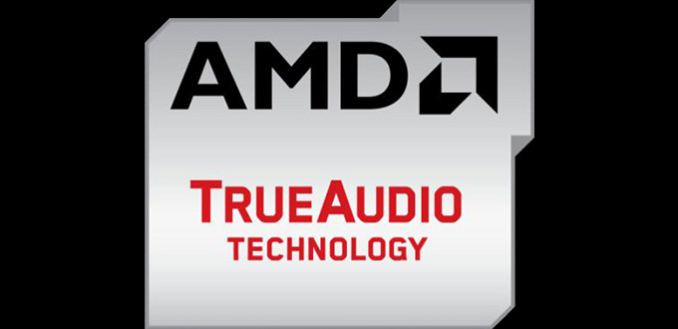
Scheduled for release today is the 1.3/AMD patch for Thief, Square Enix’s recently released stealth action game. Following last month’s Battlefield 4 patch, Thief is the second big push for AMD’s recent Radeon technology initiative, becoming the second game to support Mantle and the first game to support TrueAudio Technology.
Thief has been something of a miss from a Metacritic perspective, but from a technology perspective it’s still a very big deal for AMD and Radeon owners. As a Mantle enabled title it’s the second game to support Mantle and the first single-player game to support it. Furthermore for AMD it showcases that they have Mantle support from more developers than just EA and other Frostbite 3 users, with Square Enix joining the fray. Finally it’s the first Unreal Engine based game to support Mantle, which can be particularly important since Unreal Engine 3 is so widely used and we expect much the same for the forthcoming Unreal Engine 4.
But more excitingly the release of this patch heralds the public release of AMD’s TrueAudio technology. Where Battlefield 4 was the launch title for Mantle, Thief is the launch title for TrueAudio, being the first game to receive TrueAudio support. At the same time it also marks the start of AMD enabling TrueAudio in their drivers, and the start of their TrueAudio promotional campaign. So along with Thief, AMD is also going to be distributing demos to showcase the capabilities of TrueAudio, but more on that later.
Diving right into matters then, at the end of last week AMD was able to get the press access to today’s patch, giving us a short opportunity to look at Thief from both a Mantle perspective and a TrueAudio perspective. As this week coincides with GDC 2014 we haven’t had a ton of time to spend with Thief, so this overview is going to be relatively brief, but it has given us enough time to play with both of AMD’s technologies.
As this is a brief overview we’re going to skip recapping the technical details behind Mantle and TrueAudio. But if you haven’t read our previous works on those subjects, you can find more details on TrueAudio and Mantle in their respective articles.
Finally, launching alongside today’s Thief patch will be the latest rendition of AMD’s Catalyst drivers, Catalyst 14.3 Beta 1 (build 13.1350.1005). We don’t have a change log for these drivers at this point – expect one to be posted alongside the drivers today – but the important point is that these are the drivers intended to be used alongside the newly patched Thief and AMD’s TrueAudio demos.
| CPU: | Intel Core i7-4960X @ 4.2GHz |
| Motherboard: | ASRock Fatal1ty X79 Professional |
| Power Supply: | Corsair AX1200i |
| Hard Disk: | Samsung SSD 840 EVO (750GB) |
| Memory: | G.Skill RipjawZ DDR3-1866 4 x 8GB (9-10-9-26) |
| Case: | NZXT Phantom 630 Windowed Edition |
| Monitor: | Asus PQ321 |
| Video Cards: |
AMD Radeon R9 290X AMD Radeon R7 260X |
| Video Drivers: | AMD Catalyst 14.3 Beta 1 |
| Headphones: | Sennheiser PC 360 |
| OS: | Windows 8.1 Pro |
Mantle
First and foremost, let’s talk about Mantle. Whereas Battlefield 4 was primarily a multiplayer game, Thief is the first single player game to gain Mantle support. So although Thief isn’t the first Mantle game, by virtue of being a single player game it presents gamers and Mantle with a very different and much more tightly structured workload to work off of. Perhaps more importantly, since it is a single player game it has a much more consistent performance profile than Battlefield 4, and better still it even has a built in benchmark to go with it.
On the whole, Thief is a better than average game from a graphics technology perspective. It is a multi-platform title based on Unreal Engine 3, and at higher quality settings includes a number of graphical features such as tessellation, contact hardening shadows, and even supersample anti-aliasing (achieved through internally rendering at a higher resolution). However even with those effects, unlike Battlefield 4, Thief is much easier to CPU bottleneck. On our fastest video cards it tends to be SSAA (or very high resolutions) that leads to Thief being bottlenecked, allowing it to otherwise become CPU bottlenecked at 1080p without SSAA.
When it comes to being CPU limited, Thief’s preferences are clear: 4 cores with as much performance per thread as you can throw at it. This leads to Thief strongly favoring Intel CPUs – first the quads and then the dual cores – with AMD’s CPUs and APUs falling into place after that. As a result of these CPU bottlenecks Thief can trend very close to being a best case scenario for Mantle, so long as it’s not outright GPU bottlenecked.
With that in mind we quickly took a look at Thief’s Mantle performance on an R9 290X (Uber mode to rule out throttling) and an R7 260X to cover both a high-end GPU and a mainstream GPU. Furthermore we tested both of those configurations with a variant of the game’s Very High settings – dropping SSAA down to Low in exchange for 16x AF, alongside the game’s Low settings. Finally we ran the above against both a high-end CPU configuration of 6 cores/12 threads at 4.2GHz, and a low-end configuration of 2 cores/4 threads at 3.3GHz.
On a quick side note, AMD included the following notes with their instructions for testing Thief. In short, Mantle is up and running for all compatible AMD cards, but multi-GPU is not yet working, and memory management is in need of further optimization.
- Mantle performance for GPUs with 2GB framebuffers will receive additional optimization in a future application path for Thief™. Currently, these products may see limited gains in scenarios requiring large amount of video memory (e.g. maximum detail settings with SSAA enabled).
- Multi-GPU support under the Mantle codepath will be added to Thief in a future application patch
- As with other first-person titles, relatively smaller gains will be observed in GPU-bound scenarios
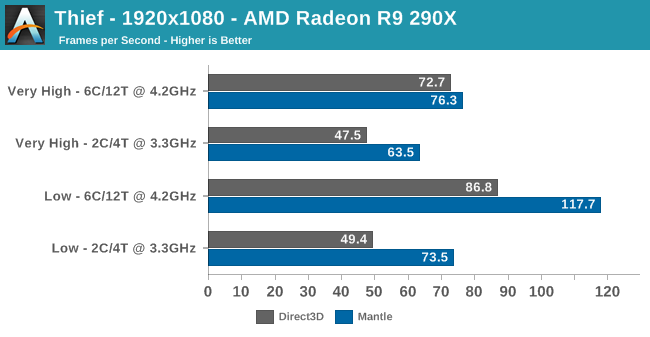
Looking first at the R9 290X, we can see that even at our modified Very High settings, there are still some small performance gains to be had from enabling Mantle. Switching out Direct3D for Mantle gets us another 3.6fps, or a 5% boost in performance. As we would expect however, a far more significant gain can be found when using Low settings. He we can see the 290X top out at 86.8fps with D3D – indicating that our earlier Very High settings weren’t all that far from being CPU bottlenecked – while Mantle boosts that up to 117.7fps, for a gain of 30.9fps or 36%.
From a practical perspective we would expect most 290X owners to be playing at settings similar to Very High, so the performance gains, though appreciated, aren’t especially influential in the long run. But it does give us some idea of what to expect.
Meanwhile if we start slowing down the CPU to just 2 cores at 3.3GHz, we can see the Mantle performance advantage grow. In this CPU bottlenecked scenario the performance gains from enabling Mantle are anywhere between 33% for Very High settings to a rather sizable 49% when using Low settings. This scenario, though contrived, makes for a good reminder of how significantly the current Direct3D rendering pipeline can bottleneck a GPU in the wrong (right?) circumstances.
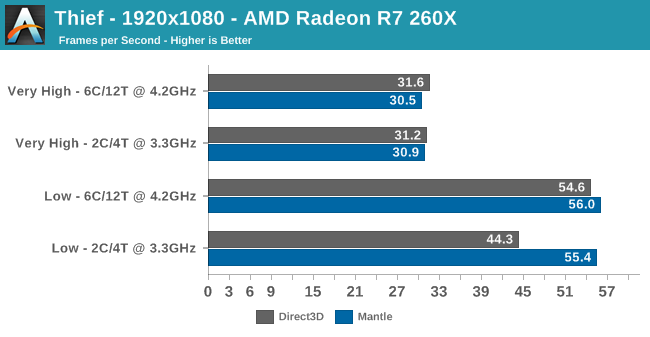
Moving on to the 260X, to no surprise we’re completely and utterly GPU bottlenecked with our Very High settings. The performance gains with Mantle are inconsequential at best, indicating that Mantle isn’t being used to significantly alter the rendering process on the GPU itself.
Shifting over to Low settings still leaves our setup GPU bottlenecked when testing against the 6 core setup, however we do see a very distinct performance gain on the 2 core setup. In this scenario enabling Mantle is worth an 11.1fps boost, or 25%, pushing the framerate up to 55.4fps.
Despite this being an artificial test on our GPU testbed, we would consider this to be a very real scenario overall given the price of the 260X. At $119 (MSRP) the 260X is very likely to be paired with a dual-core CPU or equivalent, so to see a meaningful performance gain in this scenario is promising. Whether any other Mantle-enabled single-player games will be this badly CPU limited remains to be seen, but if other games were to behave like Thief, then we may see similar gains on lower-end setups such as this.
Ultimately we’ve only had a limited amount of time with the Thief Mantle patch, so we’ll have to take a look at the competitive landscape another day. But as a pure Mantle analysis Thief is probably the greater beneficiary from Mantle at this time. The gains at the high end aren’t worth writing home about, but since we need the CPU to churn out a fairly high framerate regardless, there’s a much greater opportunity to benefit from Mantle on lower end Intel CPUs and AMD’s CPUs/APUs.


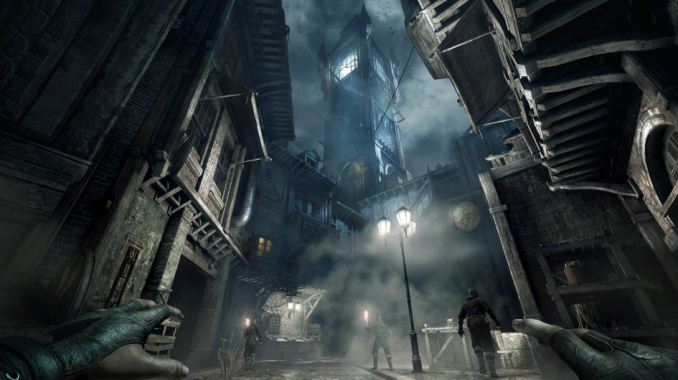
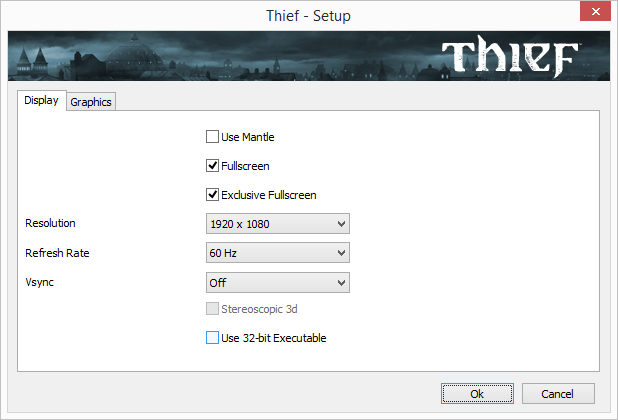









75 Comments
View All Comments
nathanddrews - Tuesday, March 18, 2014 - link
When EAX worked, it worked well. I still break it out for playing Halo PC using Alchemy. The advantage it brings in hearing approaching footsteps and chambering rounds is astonishing. I can navigate some maps almost entirely by sound. Of course, there's always the hilarity that ensues when the physics freaks out with collision detection and a warthog starts bouncing half in a wall... the audio just farts relentlessly.Come to think of it, A3D had a demo that was nearly identical to this Tuscany demo, I remember playing with it and thinking it was neat.
nathanddrews - Tuesday, March 18, 2014 - link
Ha! Found it!http://youtu.be/-oSlbyLAksM
ozzuneoj86 - Tuesday, March 18, 2014 - link
Hah! I was thinking of this too when I watched the Tuscany video. I remember playing with this on my Aureal Vortex 2 SQ2500 Superquad back in 2000. Which reminds me... what is it with old sound cards and ridiculously long product names? My brother had an Aztech Labs Sound Galaxy Washington 16A soundcard as well... how did they fit it all on a box?DroidTomTom - Tuesday, March 18, 2014 - link
Wow! I was floored by that. I felt like I was immersed in one of those adventure rides at a Theme Park. Too bad no games use anything close to this today. That was way better than the demos from my SB EAX cards. And blows away the Tuscany demo too.milli - Tuesday, March 18, 2014 - link
I'll quote wiki:'A3D uses a subset of the actual in-game 3D world data to accurately model the location of both direct (A3Dspace) and reflected (A3Dverb) sound streams (A3D 2.0 can perform up to 60 first-order reflections). EAX 1.0, the competing technology at the time promoted by Creative Labs, simulated the environment with an adjustable reverb—it didn't calculate any actual reflections off the 3D surfaces.'
Well EAX (even the newest) never got this killer feature. That's why A3D worked so well and consistent.
SilentSin - Tuesday, March 18, 2014 - link
Half Life was *the* killer app for A3D, maybe AMD can bring TrueAudio alive with HL3 ;) Way back with HL1 the framerate did take a hit from enabling A3D but it was absolutely worth it. Playing beta CS with headphones and A3D was almost like cheating, you could easily track players through walls. I think I have my vortex 2 stashed somewhere in my closet..TheElMoIsEviL - Thursday, March 20, 2014 - link
A3D had a horrible CPU utilization rate. I remember having my frame rates halved and I was using either my Voodoo 2 12MB SLI setup or my Voodoo 3 3000 16MB back then.nathanddrews - Tuesday, March 18, 2014 - link
While EAX doesn't do all the calculations, it adds custom DSP to in-game elements and each virtual environment to better reflect (no pun intended) the audio heard by the listener without impacting system performance. Long before ambient occlusion, there was aural occlusion, which EAX brought to the table after they consumed A3D.Probably the best we can hope for with AMD TrueAudio is competition from Creative in the form of A3D's resurrection... but I'd like to think that A3D (like EAX) can be adequately surpassed by modern technology.
risa2000 - Tuesday, March 18, 2014 - link
A3D was unbeatable in true HRTF processing when one was wearing headphones. I had Aureal Vortex 2 card and in Quake 3 Arena (before the patch which removed A3D sound) and in Half-Life and also Deus Ex it was like having third eye. A3D did occlusion and reverb processing of the sound sources on the scene geometry. I have never heard anything close enough since then in any game.As someone who also implemented A3D support in some graphics app, I can confirm that API was quite similar to OpenGL philosophy. The scene could be passed to OGL and A3D in very similar way (back then i.e. in 2001). There was however a drawback in CPU utilization (15-30% at that time), which today with current CPU power and resources could probably translate into negligable numbers.
So I do not think we need specialized HW for this, just standardized SW API would be enough and with current CPU, even bringing in old A3D API would definitely move the 3D sound forward.
frenchy_2001 - Tuesday, March 18, 2014 - link
The reason A3D worked so well was the 3D model of the scene they had to pass to the card.The penalty paid was mostly for the transfer of those models into the sound card memory, which happened over PCI bus (slow). As scene complexity grows, so would this cost. You also would need additional memory on the sound card.